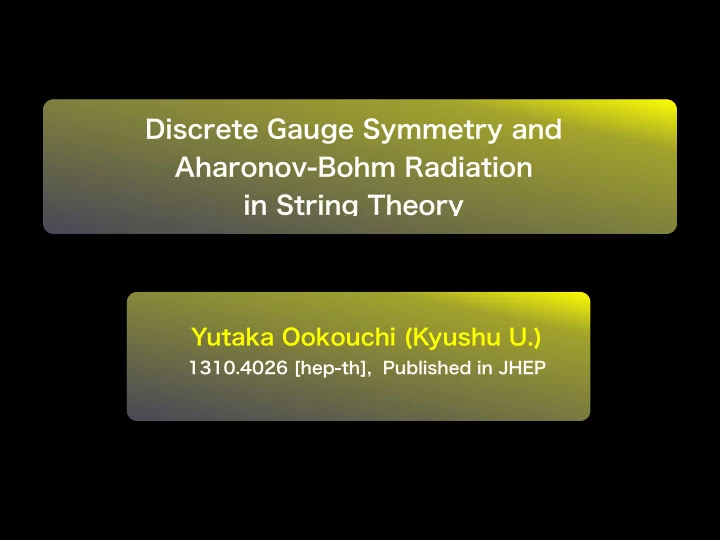

Discrete Gauge Symmetry and Aharonov-Bohm Radiation in String Theory Yutaka Ookouchi (Kyushu U.) 1310.4026 [hep-th], Published in JHEP
String theory Aharonov-Bohm effect Discrete Gauge Theory
Discrete gauge sym. is ubiquitous Consider prototype intersecting D-brane model gluon quark U (3) × Sp (2) × U (1) c × U (1) d U(3) U(1) c Sp(2) U(1) d
Extra U(1)s are massive Stuckelberg coupling In E<< t, massive field does not play any role? Claim: massive objects contribute to low energy physics via Aharonov-Bohm effect! U (3) × Sp (2) × U (1) c × U (1) d L ∼ t 2 ( d φ − pA ) ∧ ∗ ( d φ − pA )
Discrete symmetry in pheno. Discrete gauge symmetries are used for model building ・stabilizing baryons ・suppressing FCNC ・fixing quark and lepton mixing angle Banks-Seiberg gave a new argument on this subject from quantum theory of gravity [ Banks-Seiberg `10 ]
“No global symmetry” theorem Banks-Seiberg extended “no global symmetries” theorem to also include discrete symmetries In embedding a phenomenological model in string theory, such a discrete symmetry have to be gauged (if not broken explicitly)
Discrete gauge theory Universal Lagrangian of Z p gauge theory Gauge transformation is L ∼ t 2 ( d φ − pA ) ∧ ∗ ( d φ − pA ) ∗ d φ = dB 2 Z p B 2 ∧ F 2 F 2 = dA 4 D A → A + d λ , φ → φ + p λ , B 2 → B 2 + d Λ , V → V + p Λ ,
Z p particle (AB particle) an object electrically couples to the massive gauge field Z p B 2 ∧ F 2 F 2 = dA 4 D R e − i Σ 1 A Σ 1 world-line
Z p string (AB string) an object electrically couples to Kalb-Ramond field world-sheet Z p B 2 ∧ F 2 F 2 = dA 4 D R e − i Σ 2 B 2 Σ 2
Aharonov-Bohm effect p D To see an interaction of AB string with AB particle, put an AB string in space-time Consider the holonomy around the string AB string AB particle D γ
Back to string theory Toroidal orientifold models in IIA string theory the simplest standard-like model gluon quark D6 branes wrapping on 3-cycles U(3) U(1) c Sp(2) U(1) d
Chern-Simons terms Chern-Simons terms in D6 brane action ex [ Berasaluce-Gonzalez, Ibanez, Soler, Uranga `11] Γ A = k β
Aharonov-Bohm particle AB particle in this model An object electrically coupling to gauge field on D6-brane F1 string ending on D6 gluon quark = Standard model particles U(3)
Aharonov-Bohm string AB string in this model An object electrically coupling to C 5 D4-brane wrapping on β
String network After AB string creation, cosmic string network is formed ・A long string ・Small loops
Aharonov-Bohm radiation radiation power from a single cusp [Jones-Smith, Mathur, Vachaspati Nov/2009 ] explicit calculations for solenoid Massive radiation from cusps
Aharonov-Bohm radiation radiation of massless particles In our model mass of AB particle << energy scale of AB string we can apply the results to our model [Jones-Smith, Mathur, Vachaspati Nov/2009 ]
String Network → sever constraint 10 − 3 ≤ p ≤ 1
Radiative emissions of electrons or muons are constrained Big Bang Nucleosynthesis http://en.wikipedia.org/wiki/Stellar_nucleosynthesis http://astrog.phys.kyushu-u.ac.jp/index.php/標準・非標準ビッグバンモデル
Big Bang Nucleosynthesis [ Kawasaki, Kohri and Moroi `04 ]
BBN constraint
Summary 1) Radiation of SM-particles from Aharonov-Bohm strings in intersecting D-brane models 2) non-trivial cosmological constraints from BBN and γ-ray background are sever in string theory due to small reconnection probability Application of our analysis to SUSY phenomenology LSP radiation from AB R-string → Yonemoto’s poster presentation on Friday
Recommend
More recommend